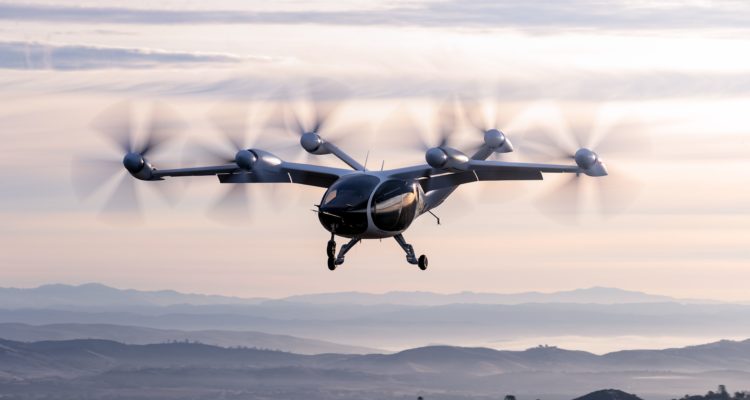On March 9, two U.S. Air Force pilots became the first airmen to fly an electric vertical takeoff and landing (eVTOL) vehicle. The milestone stems from a two-year partnership between BETA Technologies, which developed the aircraft, and Agility Prime, the Air Force’s initiative to partner with the commercial sector to accelerate development of eVTOL aircraft.
Pilots Hank Griffiths and Maj. Jonathan Appleby conducted several flight demonstrations of BETA’s ALIA aircraft at the company’s Plattsburgh, N.Y., testing facility. With a wingspan of 50 feet, the ALIA can fly 250 nautical miles and carry a pilot and three standard pallets or a pilot and five passengers.
Operating under the Air Force’s AFWERX innovation arm, Agility Prime was launched in 2020 and has awarded 22 contracts to 14 eVTOL aircraft developers, as well as more than 250 contracts to small businesses and universities to conduct research and development.
In a YouTube video promoting Agility Prime, Col. Nathan Diller, AFWERX director, said, “If there is an entirely new way of doing mobility in the air, we have to be in the middle of that.”
The Air Force is not the only organization immersed in the expansive advanced air mobility (AAM) market aimed at using transformational designs and technologies to move people and cargo more easily between destinations. An aircraft directory maintained by the Vertical Flight Society cites more than 200 companies working on eVTOL vehicles, from startups to aerospace OEMs like Boeing and the mobility service provider Uber.
There’s energy in the burgeoning market – and growing pains, too, as companies develop vehicles and move toward commercialization.
Stages of Development
“The challenge for the advanced air mobility market is that we’re aiming to eventually reach volumes more familiar to the automotive industry while retaining the extremely high standards required by aerospace regulations,” says Oliver Walker-Jones, head of marketing and communications at Joby Aviation Inc., a developer of eVTOL aircraft.
Transitioning from prototypes to full-scale production presents numerous hurdles for both aerospace leaders, with little expertise in high-volume production, and new players to the market.
“If you look at eVTOL aircraft, they are quite often being designed by people outside the normal aerospace industry,” says Jim Sherman, director of strategic development for the Vertical Flight Society. “They bring a different perspective, but they also don’t quite understand all of the nuances of getting to production and getting the necessary material and process certifications.”
Bill Bihlman, president of Aerolytics LLC, an aerospace market research and consulting firm, says there are four fundamental stages to developing new aircraft and each one is arduous.
- Functional Prototype – The first step is to build an aerodynamically stable prototype that can fly. “I don’t care what you build it out of. Build it out of balsa wood if you want,” says Bihlman. “The focus is proving that your concept is viable. But as soon as you check that box, you move onto the next round.”
- Type Certificate – The second step is receiving type certification. One of the Federal Aviation Administration’s 14 CFR Part 21 certifications, the certificate approves the design of a new aircraft and all component parts, such as propellors and engines. It indicates that the design complies with airworthiness, noise, fuel venting and exhaust emission standards.
- Production Certificate – “The production certificate, which is an extension of the type certificate, is all about quality control,” says Bihlman. “Put simply, it indicates that what you built the first time you are going to build a thousand times.” The certificate signifies that a company can repeatedly manufacture a product or article that conforms to the FAA-approved type design.
- Sustainment – During the final stage, companies prove continued airworthiness of the new aircraft, including development of a maintenance and repair strategy.
Materials and processes are key to all four steps.
In Pursuit of the Right Solution
“The advanced air mobility business model requires both manufacturing and materials excellence,” says Bihlman.
CFRP is commonly used in traditional aerospace applications, and it has become the standard for AAM. Using hand lay-up to fabricate prototypes from carbon fiber and thermoset resins works, but it presents roadblocks for high-rate production.
“You need an automated tooling and material system, which is not in place right now,” says Bihlman. “Instead of taking six to eight hours for autoclave curing we need to cure parts in minutes.”
Dana Jensen, a senior industrial policy analyst with the U.S. Air Force/Agility Prime, asserts that thermoplastic composites will need to be part of eVTOL solutions.
“Thermosets are not going to go away. It’s not a question of moving from one to the other. It’s about incorporating thermoplastics on a bigger scale,” says Jensen. “If you want to achieve high rates, then you need to move to thermoplastics. And there aren’t many qualified thermoplastic materials out there.”
It’s a monumental task to create a working prototype, one that many companies have achieved. But if a prototype built with conventional thermosets earns type certification, the company may need to go back to the drawing board to re-imagine the aircraft using thermoplastic composites or quick set thermosets to achieve production certification.
“How do you move from one material to another without having to go back and redesign the part?” says Jensen. “The more closely the prototype material and tooling resembles what you will use for production the better.”


